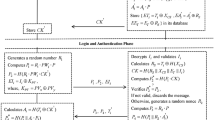Abstract
A super-connected society is emerging in which things and things or people and things communicate with each other through the Internet of Things. Since devices in the existing IoT environment have limitations such as low power, volume, and performance, a new paradigm has been suggested by integrating with cloud computing technology. However, there are still issues to resolve in the new convergence paradigm in order to mitigate vulnerabilities regarding data management and information protection for security. Thus, this study designs a RLWE-based homomorphic encryption communication protocol for user authentication and message management in a cloud computing-based IoT convergence environment. We conducted performance analysis on a communication protocols in the existing IoT environment and the proposed communication protocol to ensure safety and security. The study verified safety and security by conducting performance analysis of current IoT environment communication protocol and proposed communication protocol. The study conducted comparative analysis on time complexity and space complexity in accordance with encryption and decoding of proposed communication protocol to confirm that it provides strong security and equivalent level of efficiency. Also, by designing a communication protocol, the study aimed to provided a safe communication infrastructure from user authentication to data transfer to users.








Similar content being viewed by others
References
Park, J. (2014). Future of Internet of Things (1st ed.). ETNEWS.
Choi, Kyung, & Kim, Mi-Hui. (2016). Reseach on convergence of internet-of-things and cloud computing. JKCA, 16(5), 1–12.
Nam, H.-J. (2017). Security and privacy issues of fog computing. KICIS, 1(42).
Pyo, C. S., Kang, H. Y., Kim, N. S., & Bang, H. C. (2013). Trends and development prospects of IoT(M2M). The Journal of Korean Institute of Communication and Information Sciences, 30(8), 3–8.
Gentry, C. (2009). A fully homomorphic encryption scheme. Stanford University, Ph.D. Thesis.
Cha, H.-J. (2015). Design of the secure data management system using homomorphic encryption. KICTS, 4(15).
Gentry, C., & Halevi, S. (2011). Implementing gentry’s fully homomorphic encryption scheme. In Advances in Cryptology –EUROCRYPT, Lecture Notes in Computer Science (Vol. 6632, pp. 129–148).
Kim, J.-H. (2013). Fully homomorphic encryption scheme without key. FHE, KICS, 5(38), 428–433.
Kim, J.-H., You, S.-K., & Lee, S.-H. (2013). Fully homomorphic encryption scheme without key switching. KICS, 38(5), 428–433.
Yang, H., Kim, H., Tang, D., & Li, H. An Efficient Somewhat HE scheme over Integers and Its Variation. IETE Technical Review.
Song, Y.-J., & Park, K.-Y. (2009). Homomorphic encryption technique for database outsourcing. KIISC, 19(3), 80–89.
Brakerski, Z., Gentry, C., & Vaikuntanathan, V. (2011). Fully homomorphic encryption without bootstrapping. IACR Eprint Archive.
Yang, H., & Kim, H. (2013). A fully homomorphic encryption scheme based on somewhat homomorphic encryption scheme with two integers. In Proceedings of KICS winter conference 2013 (pp. 76–77).
Kim, S.-J., Kim, J.-M., & Cho, I.-J. (2012). Design of configuration management using homomorphic encryption in mobile cloud service. KIICE, 16(10), 2217–2223.
Kim, H.-S., & Lee, S.-W. (2013). Homomorphic encryption scheme and applications for cloud computing security. SERSC, 10(2), 213–224.
Cho, N.-S., & Hong, D.-W. (2008). Technical trend of the searchable encryption system. ETRI, 23(4).
Stehle, D., & Steinfeld, R. (2010). Faster fully homomorphic encryption. Lecture Notes in Computer Science, 6477, 377–394.
Damgard, I., & Jurik, M. (2001). A generalization, a simplification and some applications of Paillier’s probabilistic public-key system. In Public Key Cryptography—PKC (pp. 119–136).
Gennaro, R., Gentry, C., & Parno, B. (2010). Non-interactive verifiable computing: Outsourcing computation to untrusted workers. Lecture Notes in Computer Science, 6223, 465–482.
Rivest, R., Addleman, L., & Dertouzos, M. (1978). On data banks and privacy homomorphism. In Foundations of secure computation (pp. 169–177).
Kolesnikov, V., Sadeghi, A., & Schneider, T. (2009). How to combine homomorphic encryption and garbled circuits—Improved circuits and computing the minimum distance efficiently. In: Proceedings of SPEED 2009 (pp. 100–121).
Author information
Authors and Affiliations
Corresponding author
Additional information
Publisher's Note
Springer Nature remains neutral with regard to jurisdictional claims in published maps and institutional affiliations.
Rights and permissions
About this article
Cite this article
Jin, BW., Park, JO. & Mun, HJ. A Design of Secure Communication Protocol Using RLWE-Based Homomorphic Encryption in IoT Convergence Cloud Environment. Wireless Pers Commun 105, 599–618 (2019). https://doi.org/10.1007/s11277-018-6083-9
Published:
Issue Date:
DOI: https://doi.org/10.1007/s11277-018-6083-9




